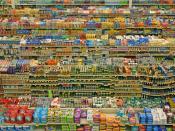This paper is a discussion of a debate between Julian L. Simon, author of The Ultimate Resource, and David Pimentel et al., authors of the article "Impact of Population Growth on Food Supplies and Environment". The debate centers on the question: "Will the World Be Able to Feed Itself in the Foreseeable Future?" I will summarize each side's argument, identify the key point over which they most basically disagree, and explain what I would like to know more about in order to arrive at my own position on the issue.
Simon argues that with our present technology, and with the technology that is still being developed, the world will easily be able to feed itself, regardless of the increasing size of its population. He explains how food production adheres to the law of supply and demand: an increase in population and income will produce a higher demand for food.
For a short time some foods may become scarce. Rising food prices due to the scarcity will prompt agronomical researchers and farmers to invent better methods of producing food and therefore increase the food production. He emphasizes that this pattern can only continue if the agriculturally productive countries promote entrepreneurship and economic freedom.
Simon points out that "the capacity of food-factory production has expanded to a degree almost beyond belief." (Simon, p. 115). He describes how hydroponic farming, which involves indoor, factory-controlled conditions, is more land efficient and produces higher quality produce than traditional farming methods. He also argues that our food supplies are not limited by the amount of sunlight falling on green plants due to the availability of nuclear as well as non-nuclear power (such as solar cells, wind, and ocean currents) to make light. Simon also names other existing technology, such as bovine growth hormone and genetically...


